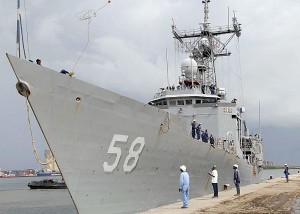 Given that many of the anti-Littoral Combat Ship (LCS) crowd have adapted the FFG-7 Oliver Hazard Perry Class Frigates as a sort of “alternative” to the LCS (a legacy shipbuilding program that, in the opinion of the anti-LCS crowd, was everything the LCS program is not), a nice dose of history might be in order.
Given that many of the anti-Littoral Combat Ship (LCS) crowd have adapted the FFG-7 Oliver Hazard Perry Class Frigates as a sort of “alternative” to the LCS (a legacy shipbuilding program that, in the opinion of the anti-LCS crowd, was everything the LCS program is not), a nice dose of history might be in order.
Those who now love the FFG-7 program probably don’t realize that the FFG-7, in its early days, was the LCS of the Seventies.
Don’t believe me? Here’s an excerpt from a June 1977 paper entitled “The U.S. Sea Control Mission: Forces, Capabilities, and Requirements,” detailing criticism leveled by, back then, the trendy-minded, well-heeled anti-FFG-7 crowd. Read the passage. The LCS, today, is facing similar bellyaching:
“The FFG-7 program has met with considerable criticism in recent years on several accounts. It has proved far more costly than originally planned: estimates of its unit cost rose from about $65 million to $168 million in constant dollars in just three years. At the same time, serious questions have been raised about its capabilities. Critics claim that the FFG lacks firepower and redundant sensors for operat
ions in high-threat areas; that its single screw propulsion renders it vulnerable to attackers; that it lacks size and capacity for low-cost, mid-life modifications. Other critics have suggested that the FFG is too slow for conducting ASW operations against modern Soviet submarines. The House Armed Services Committee was particularly critical of the FFG program…”
That’s quite an inauspicious beginning…But today, more than 30 years after introduction, FFG-7s remain efficient enough for modern Navies to operate–and valuable enough to upgrade.
Look closely at those cost estimates. Plug the first FFG-7 cost estimate into an inflation calculator and the result is $230 million–almost exactly the same amount of money the Navy first programmed for the LCS.
Shove that final 1977 FFG-7 cost estimate of $168 million into an inflation calculator, and the end result is $595 million in 2009 dollars. Today, the LCS-3 and 4 cost $548.8 million and $547.7 million respectively. If one of the two LCS designs functions as advertised–and are hiding no major flaws–then we’ve got a pretty interesting higher-end FFG-7-like replacement platform.
That bit of context might give LCS critics something to think about. Of course, even with the “FFG-7 was/is better than the LCS” platform knocked about a bit, the debate over whether or not a less costly ship model might serve just as well as an LCS remains valid…and valuable.

{ 3 comments }
I didn’t think that the LCS has built in Sonar? Maybe as part of the ASW module but not as part of the ship.
Not to mention that the “Anti-Submarine” role of the LCS is totally BOGUS, since it’s only ASW equipment are SONAR and a Helicopter…
Ah but compare the capabilites between the two (or three I guess with lcs-1 and 2) and you are getting much more for your money with the FFG-7’s. At least in original configuration/builds. Missile launcher with SM-1 and Harpoon so you have anti-air and ship capabilities, hull mounted and towed array sonar, torpedoes, robust hull design as evidenced by the Stark and Samuel B. Roberts incidents, much longer endurance, and in short a ship that is designed for combat. Yet Navy leadership is saying LCS is a replacement for the FFG-7 program?
P.S. Just got over here from the old site. Hence the dates.
Comments on this entry are closed.